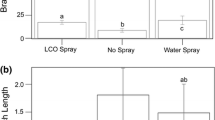Abstract
Development of the idea that carbohydrates digested from cell walls could carry the information necessary to “activate” host defense responses to pathogens began in the 1970s. Early work (Ayers et al., 1976) demonstrated that a glucan derived from cell walls of the soybean pathogen Phytophthora megasperma f. sp. glycinea could elicit the synthesis of phytoalexins by soybean tissues. Subsequent studies have identified a heptasaccharide subfragment of the hyphal wall glucan, presumably generated by the action of soybean-produced glucan hydrolases, as the most active component (Sharp et al., 1984). Studies in recent years have identified similar responses in several cell culture and tissue systems. The production of phytoalexins and other presumed “defense” compounds in response to elicitors derived from host, as well as pathogen, cell walls has been described (Darvill and Albersheim, 1984; Lamb et al., 1986). Most recently these studies have utilized the techniques of molecular genetics to follow responses at the level of gene transcription (e.g., Bell et al., 1986). Genome activation with a lag time as short as 5 to 10 minutes has been shown (Lawton and Lamb, 1987). Questions about the means by which cells perceive the presence of elicitors (Schmidt and Ebel, 1987) and then mobilize their responses remain. However, it is clear that the biochemical confrontation at the infection site often includes many enzymes that can generate elicitor-active wall fragments.
Access this chapter
Tax calculation will be finalised at checkout
Purchases are for personal use only
Preview
Unable to display preview. Download preview PDF.
Similar content being viewed by others
References
Ayers A, Valent B, Ebel J, Albersheim P (1976) Host-pathogeninteractions XI. Composition and strcuture of wall-released elicitor fractions. Plant Physiol 57:766–774
Baldwin E, Pressey R (1988) Tomato polygalacturonase elicits ethylene production in tomato fruit. J Am Soc Hort Sci 113:92–95
Bell J, Ryder T, Wingate V, Bailey J, Lamb C (1986) Differential accumulation of plant defense gene transcripts in a compatible and incompatible plant-pathogen interaction. Mol Cell Biol 6:1615–1623
Blumenkrantz N, Asboe-Hansen G (1973) A new method for quantitative determination of uronic acids. Anal Biochem 54:484–489
Brecht J, Huber D (1988) Products released from enzymically active cell wall stimulate ethylene production and ripening in preclimacteric tomato (Lycopersicon esculentum Mill.) fruit. Plant Physiol 88:1037–1041
Darvill, A, Albersheim P (1984) Phytoalexins and their elicitors — A defense against microbial infection in plants. Ann Rev Plant Physiol 35:243–275
Hayashi T, Wong Y, Maclachlan G (1984) Pear xyloglucan and cellulose. II. Hydrolysis by pear endo-l,4-β-glucanases. Plant Physiol 75:605–610
Kader A, Stevens MA, Albright-Holton M (1977) Effect of fruit ripeness when picked on flavor and composition in fresh market tomatoes. J Am SocHort Sci 102:724–731
Labavitch J (1983) Stimulation of fruit ethylene production. Plant Physiol 72 (Suppl):158
Labavitch J, Ray P (1974) Turnover of polysaccharies in elongating pea stem segments. Plant Physiol 53:669–673
Lamb C, Corbin D, Lawton M, Sauer N, Wingate V (1986) Recognition and response in plant:pathogen interactions. In: Lugtenberg B (ed) Recognition in Microbe-Plant Symbiotic and Pathogenic Interactions, Springer-Verlag, Berlin Heidelberg pp 333–344
Lawton M, Lamb C (1987) Transcriptional activation of plant defense genes by fungal elicitor, wounding and infection. Mol Cell Biol 7:335–341.
Morrison J, Polito V (1985) Gum duct formation in almond fruit, Prunus dulcis (Mill.) D.W. Webb. Bot Gaz 146:15–25
Puschmann R, Romani R (1983) Ethylene production by auxin-deprived, suspension-cultured pear fruit cells in response to auxins, stress or precursor. Plant Physiol 73:1013–1019
Rasmussen H, Buckovac M (1969) A histochemical study of abscission layer formation in the bean. Am J Bot 56:69–82
Schmidt W, Ebel J (1987) Specific binding of a fungal glucan phytoalexin elicitor to membrane fractions from soybean Glycine max. Proc Natl Acad Sci USA 84:4117–4121
Sharp J, McNeil M, Albersheim P (1984) The primary structure of one elicitor-active and seven elicitor-inactive hexa (β-D-glucopyranosyl)-D-glucitols isolated from the mycelial wall of Phvtophthora megasperma f. sp. glvcinea. J Biol Chem 259:11321–11326
Tong C, Labavitch J, Yang S (1986) The induction of ethylene production from pear cell culture by cell wall fragments. Plant Physiol 81:929–930
VanderMolen G, Labavitch J, Strand L, DeVay J (1983) Pathogen-induced vascular gels. Ethylene as a host intermediate. Physiol Plant 59:573–580
Weis K, Polito V, Labavitch J (1988) Microfluorometry of pectic materials in the dehiscense zone of almond (Prunus dulcis [Mill.] DA Webb) fruits. J Histochem Cytochem 36:1037–1041
York W, Darvill A, Albersheim P (1984) Inhibition of 2,4-dichlorophenoxy-acetic acid-stimulated elongation of pea stem segments by a xyloglucan oligosaccharide. Plant Physiol 75:295–297
Author information
Authors and Affiliations
Editor information
Editors and Affiliations
Rights and permissions
Copyright information
© 1989 Springer-Verlag Berlin Heidelberg
About this chapter
Cite this chapter
Campbell, A., Labavitch, J. (1989). Cell Wall-Derived Elicitors—Are they Natural (Endogenous) Regulators?. In: Osborne, D.J., Jackson, M.B. (eds) Cell Separation in Plants. NATO ASI Series, vol 35. Springer, Berlin, Heidelberg. https://doi.org/10.1007/978-3-642-74161-6_11
Download citation
DOI: https://doi.org/10.1007/978-3-642-74161-6_11
Publisher Name: Springer, Berlin, Heidelberg
Print ISBN: 978-3-642-74163-0
Online ISBN: 978-3-642-74161-6
eBook Packages: Springer Book Archive




